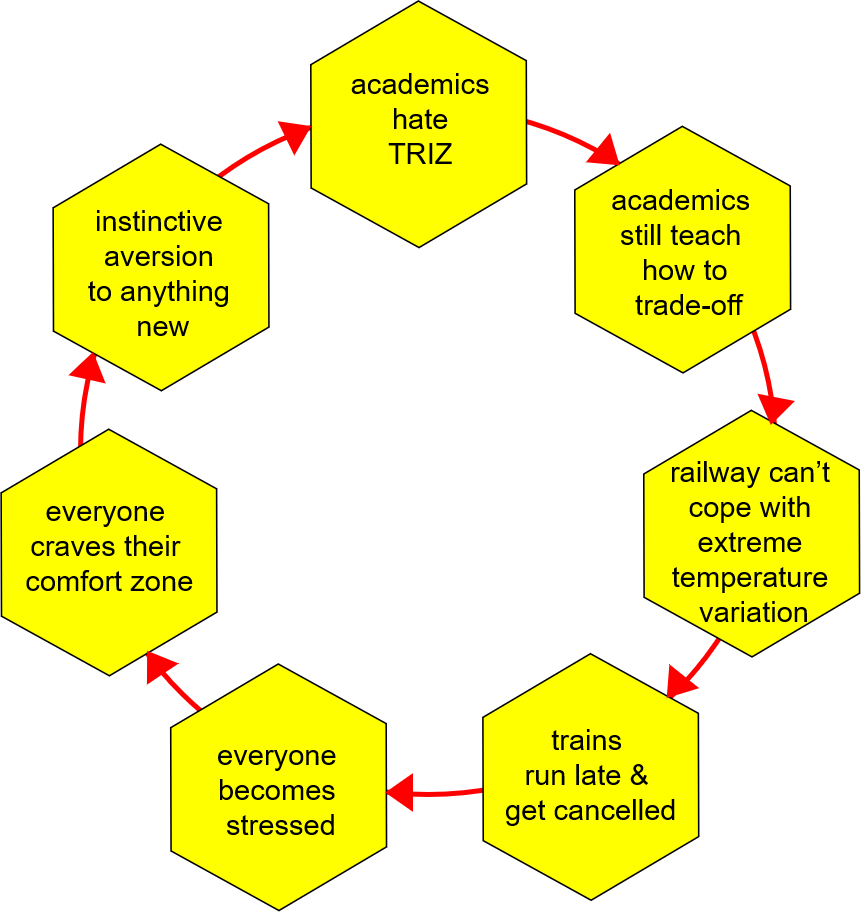
Parts of the UK had their hottest July temperature ever this week. One or two spots had their hottest day ever. By about 0.2 degC. You could spot the hottest places by the train system chaos the extra 0.2degC created.
In recent years, the ill-starred British commuter has had to put up with a number of things. First we had the wrong kind of snow. Then we had leaves on the line. Now we’ve got sagging overhead power lines and buckling track.
Metal things expand when they gets hot. I get that. I learned about it in my first-year engineering degree. No, scratch that, I first learned about it in Physics class when I was about 11. What I learned in the first-year of my degree was how to design structures that were able to handle changing temperatures.
What I was taught was this. One, establish how big the range of temperatures might be. Two, add some safety margin. Three, work out the mean and median temperatures and use these as your ‘design point’. Four, once you’ve created the basic ‘average’ condition state, build in appropriate tolerances and make sure that the system still operates safely at the edge of these tolerances. And, if it can’t, put in place measures that prevent people operating the system outside the safe limits.
So, on one level, you’ve got to have some sympathy with the railway engineers in the UK. Some. Not much, but some. Climate change is meaning that highs are getting higher and lows are getting lower. The only thing we might fault them on here is their over-eagerness in Step Two above to minimise safety margins. No doubt because, the engineering college notes will tell you that more safety margin means adding more material, and that in turn means the system gets more expensive. I get that too.
The real problem here are the academics that taught those engineering design courses. People who, for the most part, don’t understand Ashby’s Law. Only variety can absorb variety. Which, in terms of designing rail track and overhead power cables means that if there is variation in the environment in which the design has to operate, there needs to be an equivalent amount of variability in the design to be able to cope with it. Taking a stance that says the designer should design for a so-called ‘optimum’ middle-ground design point, and then prevent the system from working outside the range of environmental variation, does not obey Ashby’s Law. What it does is mean that millions of commuters have a miserable journey home on very hot days.
The deeper problem here, however, is that not only do the academics not understand Ashby’s Law, they also have a virulent allergic reaction to TRIZ. Probably because they never learned about it in the first-year college notes they took when they were being taught engineering design. I can’t blame them for that. But I can – and do – blame them for not being willing to listen now that the world does know about it.
What TRIZ tells us is that variety in operating conditions very likely creates a contradiction: we want the overhead power lines to be the right length when the weather is hot, and we also want it to be the right length when the weather is cold. Or, better yet, if we think in terms of something else TRIZ tells us – ‘the customer wants the function‘ – we want power to be successfully transferred from the grid to the train when the weather is hot and cold.
Once we’ve found the contradiction, guaranteed someone, somewhere has already solved it. There are dozens of smart ways to solve the contradiction. Ditto when we then hit the next inevitable contradiction (probably cost-related). The real problem here is no-one has been looking for contradictions. And no-one has been looking for them, because no-one taught them they were a valid thing to go look for.
Which in turn means society has a complex problem to solve. Which then means that there is no ‘root-cause’ (another academic failing!). Which means we need to go look for ‘conspiracies of causes. Which, finally, with tongue slightly in cheek, tells us the vicious cycle that needs to be broken in order to create a railway system that works whatever the weather pretty much comes down to this…

